Exploring Six Sigma's Role: A Literature Review on Service Quality
VerifiedAdded on 2023/06/14
|8
|3223
|207
Literature Review
AI Summary
This literature review provides an overview of Six Sigma's contribution to service quality improvement, focusing on its methodologies, tools, and implementation challenges. It begins by introducing the importance of service quality in today's business environment and the role of Six Sigma in addressing organizational challenges. The review defines Six Sigma, highlighting its data-driven approach and its various methodologies like DMAIC and DMADV. It explores different approaches to Six Sigma implementation, including change tactics, incremental improvements, and ongoing critical thinking. Furthermore, the review identifies various tools and techniques used within Six Sigma, such as flowcharts, check sheets, and statistical process control. The research objectives include investigating the level to which Six Sigma contributes to quality improvement, identifying specific Six Sigma tools for enhancing customer service quality within Amazon, and recognizing the challenges in adopting Six Sigma within Amazon. Overall, the literature review aims to provide a comprehensive understanding of Six Sigma's role in enhancing service quality and its practical application within organizations like Amazon.
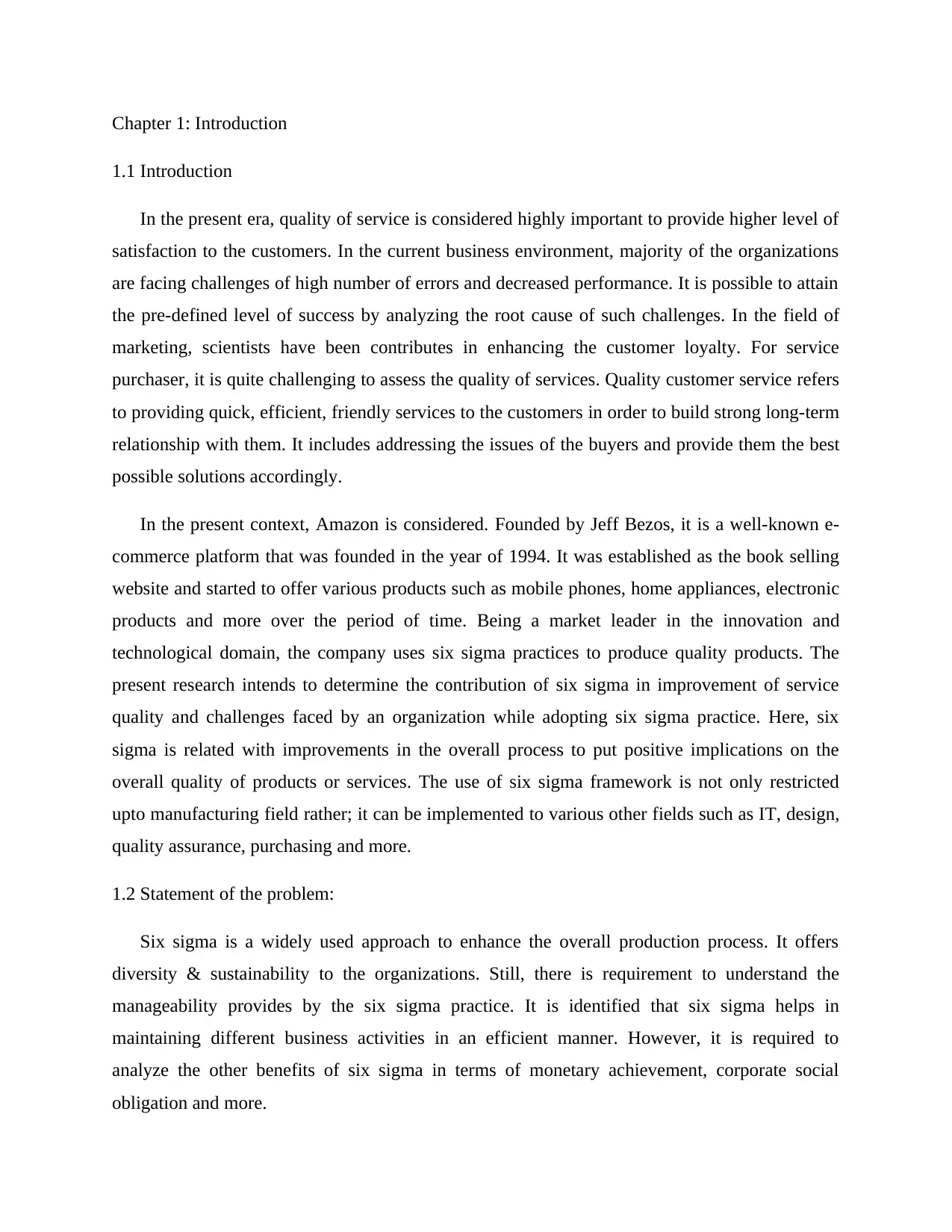
Chapter 1: Introduction
1.1 Introduction
In the present era, quality of service is considered highly important to provide higher level of
satisfaction to the customers. In the current business environment, majority of the organizations
are facing challenges of high number of errors and decreased performance. It is possible to attain
the pre-defined level of success by analyzing the root cause of such challenges. In the field of
marketing, scientists have been contributes in enhancing the customer loyalty. For service
purchaser, it is quite challenging to assess the quality of services. Quality customer service refers
to providing quick, efficient, friendly services to the customers in order to build strong long-term
relationship with them. It includes addressing the issues of the buyers and provide them the best
possible solutions accordingly.
In the present context, Amazon is considered. Founded by Jeff Bezos, it is a well-known e-
commerce platform that was founded in the year of 1994. It was established as the book selling
website and started to offer various products such as mobile phones, home appliances, electronic
products and more over the period of time. Being a market leader in the innovation and
technological domain, the company uses six sigma practices to produce quality products. The
present research intends to determine the contribution of six sigma in improvement of service
quality and challenges faced by an organization while adopting six sigma practice. Here, six
sigma is related with improvements in the overall process to put positive implications on the
overall quality of products or services. The use of six sigma framework is not only restricted
upto manufacturing field rather; it can be implemented to various other fields such as IT, design,
quality assurance, purchasing and more.
1.2 Statement of the problem:
Six sigma is a widely used approach to enhance the overall production process. It offers
diversity & sustainability to the organizations. Still, there is requirement to understand the
manageability provides by the six sigma practice. It is identified that six sigma helps in
maintaining different business activities in an efficient manner. However, it is required to
analyze the other benefits of six sigma in terms of monetary achievement, corporate social
obligation and more.
1.1 Introduction
In the present era, quality of service is considered highly important to provide higher level of
satisfaction to the customers. In the current business environment, majority of the organizations
are facing challenges of high number of errors and decreased performance. It is possible to attain
the pre-defined level of success by analyzing the root cause of such challenges. In the field of
marketing, scientists have been contributes in enhancing the customer loyalty. For service
purchaser, it is quite challenging to assess the quality of services. Quality customer service refers
to providing quick, efficient, friendly services to the customers in order to build strong long-term
relationship with them. It includes addressing the issues of the buyers and provide them the best
possible solutions accordingly.
In the present context, Amazon is considered. Founded by Jeff Bezos, it is a well-known e-
commerce platform that was founded in the year of 1994. It was established as the book selling
website and started to offer various products such as mobile phones, home appliances, electronic
products and more over the period of time. Being a market leader in the innovation and
technological domain, the company uses six sigma practices to produce quality products. The
present research intends to determine the contribution of six sigma in improvement of service
quality and challenges faced by an organization while adopting six sigma practice. Here, six
sigma is related with improvements in the overall process to put positive implications on the
overall quality of products or services. The use of six sigma framework is not only restricted
upto manufacturing field rather; it can be implemented to various other fields such as IT, design,
quality assurance, purchasing and more.
1.2 Statement of the problem:
Six sigma is a widely used approach to enhance the overall production process. It offers
diversity & sustainability to the organizations. Still, there is requirement to understand the
manageability provides by the six sigma practice. It is identified that six sigma helps in
maintaining different business activities in an efficient manner. However, it is required to
analyze the other benefits of six sigma in terms of monetary achievement, corporate social
obligation and more.
Paraphrase This Document
Need a fresh take? Get an instant paraphrase of this document with our AI Paraphraser
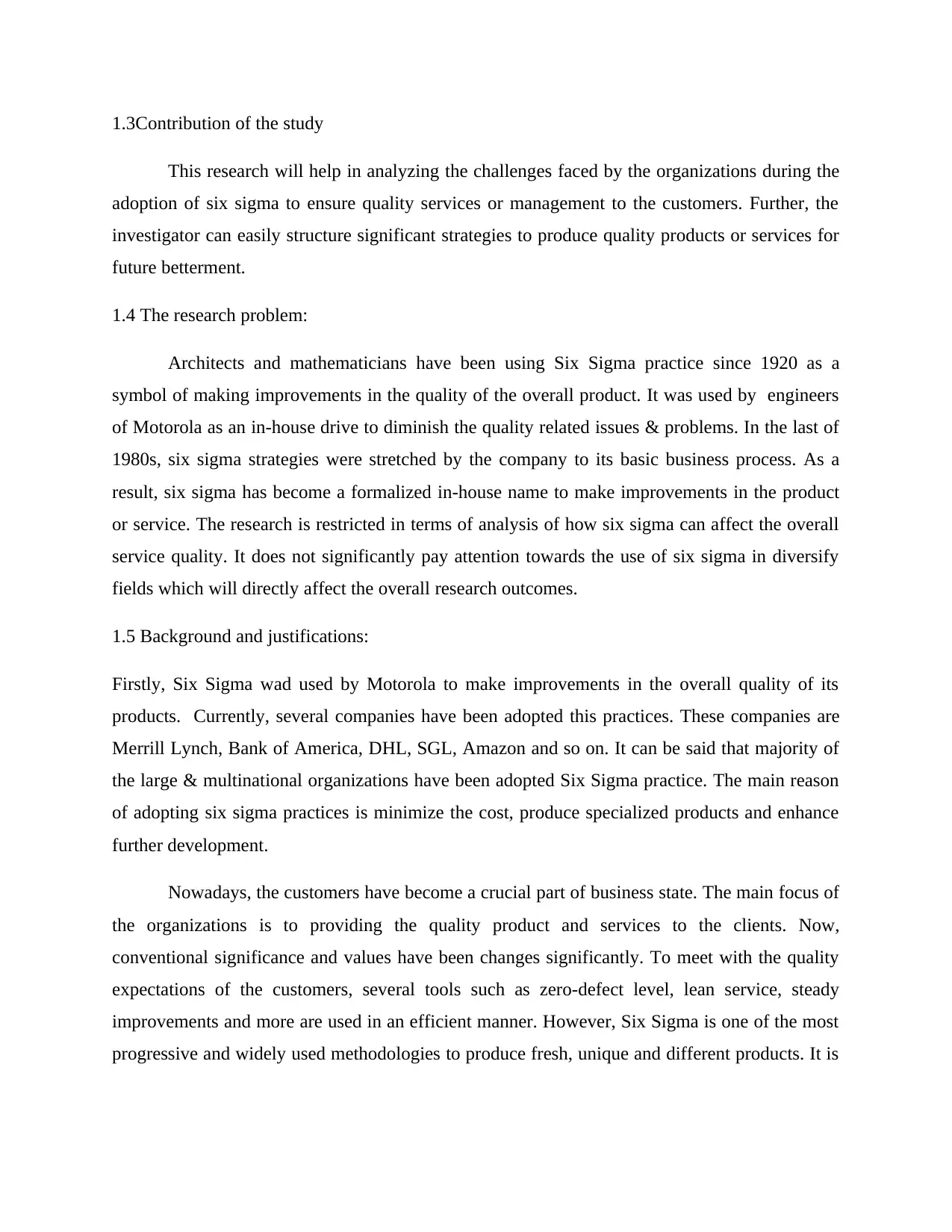
1.3Contribution of the study
This research will help in analyzing the challenges faced by the organizations during the
adoption of six sigma to ensure quality services or management to the customers. Further, the
investigator can easily structure significant strategies to produce quality products or services for
future betterment.
1.4 The research problem:
Architects and mathematicians have been using Six Sigma practice since 1920 as a
symbol of making improvements in the quality of the overall product. It was used by engineers
of Motorola as an in-house drive to diminish the quality related issues & problems. In the last of
1980s, six sigma strategies were stretched by the company to its basic business process. As a
result, six sigma has become a formalized in-house name to make improvements in the product
or service. The research is restricted in terms of analysis of how six sigma can affect the overall
service quality. It does not significantly pay attention towards the use of six sigma in diversify
fields which will directly affect the overall research outcomes.
1.5 Background and justifications:
Firstly, Six Sigma wad used by Motorola to make improvements in the overall quality of its
products. Currently, several companies have been adopted this practices. These companies are
Merrill Lynch, Bank of America, DHL, SGL, Amazon and so on. It can be said that majority of
the large & multinational organizations have been adopted Six Sigma practice. The main reason
of adopting six sigma practices is minimize the cost, produce specialized products and enhance
further development.
Nowadays, the customers have become a crucial part of business state. The main focus of
the organizations is to providing the quality product and services to the clients. Now,
conventional significance and values have been changes significantly. To meet with the quality
expectations of the customers, several tools such as zero-defect level, lean service, steady
improvements and more are used in an efficient manner. However, Six Sigma is one of the most
progressive and widely used methodologies to produce fresh, unique and different products. It is
This research will help in analyzing the challenges faced by the organizations during the
adoption of six sigma to ensure quality services or management to the customers. Further, the
investigator can easily structure significant strategies to produce quality products or services for
future betterment.
1.4 The research problem:
Architects and mathematicians have been using Six Sigma practice since 1920 as a
symbol of making improvements in the quality of the overall product. It was used by engineers
of Motorola as an in-house drive to diminish the quality related issues & problems. In the last of
1980s, six sigma strategies were stretched by the company to its basic business process. As a
result, six sigma has become a formalized in-house name to make improvements in the product
or service. The research is restricted in terms of analysis of how six sigma can affect the overall
service quality. It does not significantly pay attention towards the use of six sigma in diversify
fields which will directly affect the overall research outcomes.
1.5 Background and justifications:
Firstly, Six Sigma wad used by Motorola to make improvements in the overall quality of its
products. Currently, several companies have been adopted this practices. These companies are
Merrill Lynch, Bank of America, DHL, SGL, Amazon and so on. It can be said that majority of
the large & multinational organizations have been adopted Six Sigma practice. The main reason
of adopting six sigma practices is minimize the cost, produce specialized products and enhance
further development.
Nowadays, the customers have become a crucial part of business state. The main focus of
the organizations is to providing the quality product and services to the clients. Now,
conventional significance and values have been changes significantly. To meet with the quality
expectations of the customers, several tools such as zero-defect level, lean service, steady
improvements and more are used in an efficient manner. However, Six Sigma is one of the most
progressive and widely used methodologies to produce fresh, unique and different products. It is
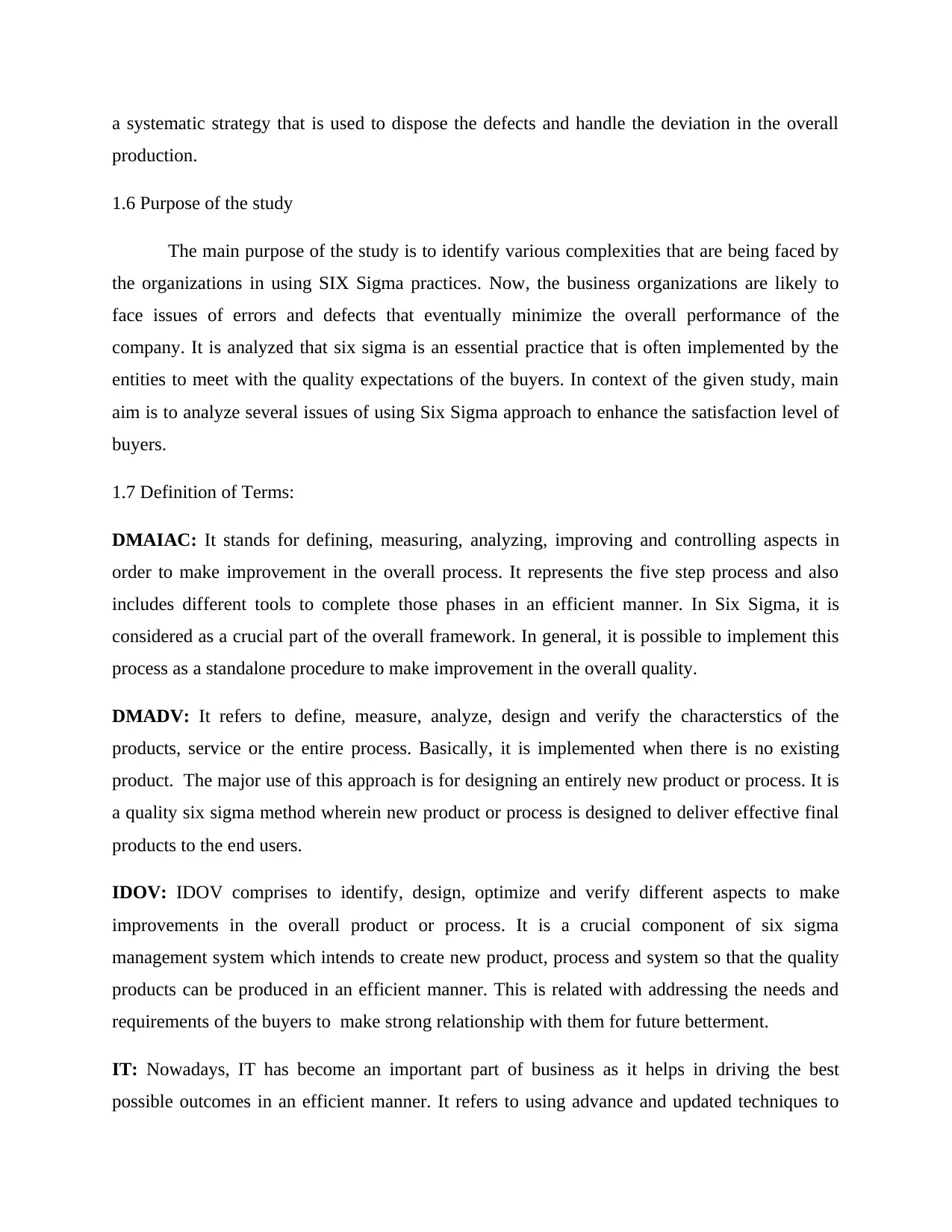
a systematic strategy that is used to dispose the defects and handle the deviation in the overall
production.
1.6 Purpose of the study
The main purpose of the study is to identify various complexities that are being faced by
the organizations in using SIX Sigma practices. Now, the business organizations are likely to
face issues of errors and defects that eventually minimize the overall performance of the
company. It is analyzed that six sigma is an essential practice that is often implemented by the
entities to meet with the quality expectations of the buyers. In context of the given study, main
aim is to analyze several issues of using Six Sigma approach to enhance the satisfaction level of
buyers.
1.7 Definition of Terms:
DMAIAC: It stands for defining, measuring, analyzing, improving and controlling aspects in
order to make improvement in the overall process. It represents the five step process and also
includes different tools to complete those phases in an efficient manner. In Six Sigma, it is
considered as a crucial part of the overall framework. In general, it is possible to implement this
process as a standalone procedure to make improvement in the overall quality.
DMADV: It refers to define, measure, analyze, design and verify the characterstics of the
products, service or the entire process. Basically, it is implemented when there is no existing
product. The major use of this approach is for designing an entirely new product or process. It is
a quality six sigma method wherein new product or process is designed to deliver effective final
products to the end users.
IDOV: IDOV comprises to identify, design, optimize and verify different aspects to make
improvements in the overall product or process. It is a crucial component of six sigma
management system which intends to create new product, process and system so that the quality
products can be produced in an efficient manner. This is related with addressing the needs and
requirements of the buyers to make strong relationship with them for future betterment.
IT: Nowadays, IT has become an important part of business as it helps in driving the best
possible outcomes in an efficient manner. It refers to using advance and updated techniques to
production.
1.6 Purpose of the study
The main purpose of the study is to identify various complexities that are being faced by
the organizations in using SIX Sigma practices. Now, the business organizations are likely to
face issues of errors and defects that eventually minimize the overall performance of the
company. It is analyzed that six sigma is an essential practice that is often implemented by the
entities to meet with the quality expectations of the buyers. In context of the given study, main
aim is to analyze several issues of using Six Sigma approach to enhance the satisfaction level of
buyers.
1.7 Definition of Terms:
DMAIAC: It stands for defining, measuring, analyzing, improving and controlling aspects in
order to make improvement in the overall process. It represents the five step process and also
includes different tools to complete those phases in an efficient manner. In Six Sigma, it is
considered as a crucial part of the overall framework. In general, it is possible to implement this
process as a standalone procedure to make improvement in the overall quality.
DMADV: It refers to define, measure, analyze, design and verify the characterstics of the
products, service or the entire process. Basically, it is implemented when there is no existing
product. The major use of this approach is for designing an entirely new product or process. It is
a quality six sigma method wherein new product or process is designed to deliver effective final
products to the end users.
IDOV: IDOV comprises to identify, design, optimize and verify different aspects to make
improvements in the overall product or process. It is a crucial component of six sigma
management system which intends to create new product, process and system so that the quality
products can be produced in an efficient manner. This is related with addressing the needs and
requirements of the buyers to make strong relationship with them for future betterment.
IT: Nowadays, IT has become an important part of business as it helps in driving the best
possible outcomes in an efficient manner. It refers to using advance and updated techniques to
⊘ This is a preview!⊘
Do you want full access?
Subscribe today to unlock all pages.

Trusted by 1+ million students worldwide
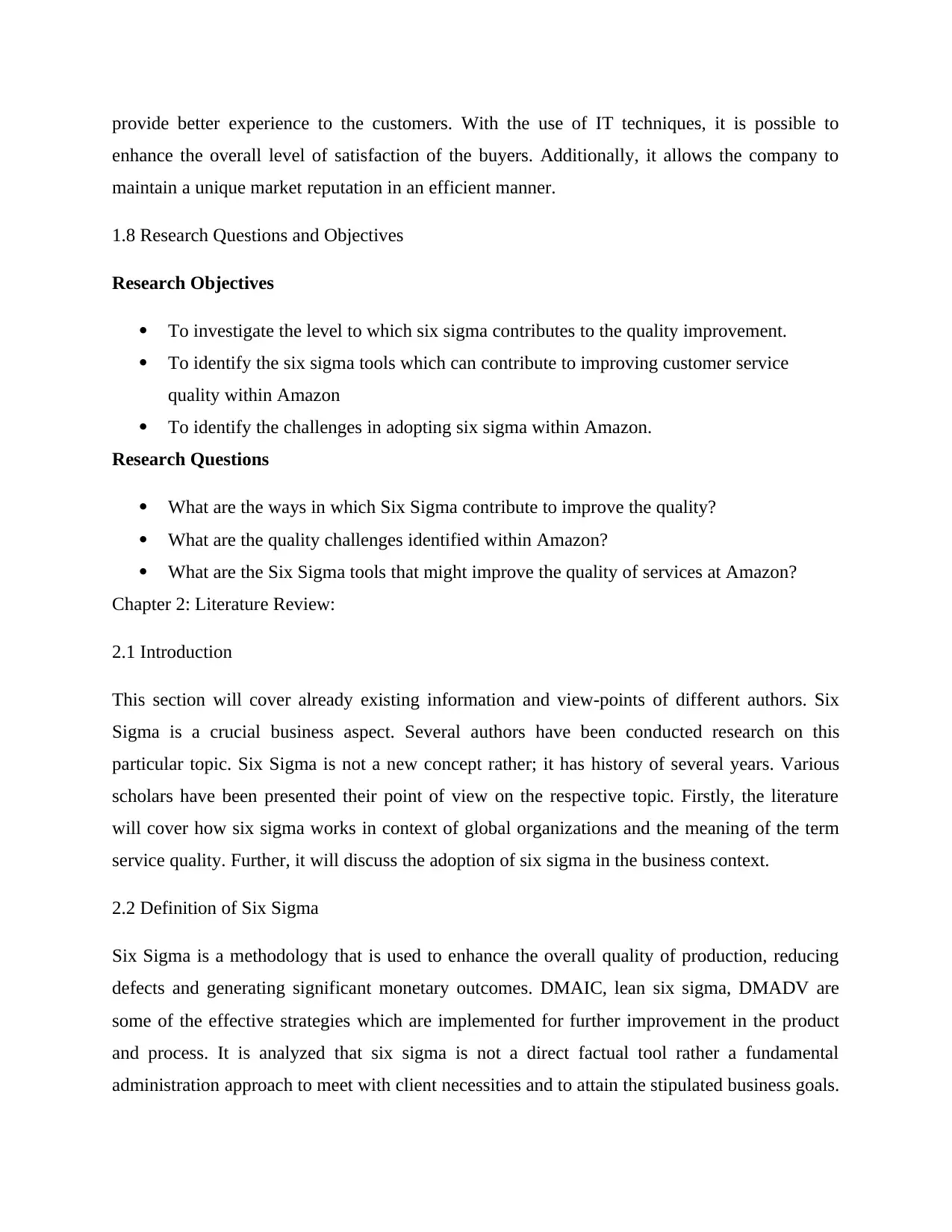
provide better experience to the customers. With the use of IT techniques, it is possible to
enhance the overall level of satisfaction of the buyers. Additionally, it allows the company to
maintain a unique market reputation in an efficient manner.
1.8 Research Questions and Objectives
Research Objectives
To investigate the level to which six sigma contributes to the quality improvement.
To identify the six sigma tools which can contribute to improving customer service
quality within Amazon
To identify the challenges in adopting six sigma within Amazon.
Research Questions
What are the ways in which Six Sigma contribute to improve the quality?
What are the quality challenges identified within Amazon?
What are the Six Sigma tools that might improve the quality of services at Amazon?
Chapter 2: Literature Review:
2.1 Introduction
This section will cover already existing information and view-points of different authors. Six
Sigma is a crucial business aspect. Several authors have been conducted research on this
particular topic. Six Sigma is not a new concept rather; it has history of several years. Various
scholars have been presented their point of view on the respective topic. Firstly, the literature
will cover how six sigma works in context of global organizations and the meaning of the term
service quality. Further, it will discuss the adoption of six sigma in the business context.
2.2 Definition of Six Sigma
Six Sigma is a methodology that is used to enhance the overall quality of production, reducing
defects and generating significant monetary outcomes. DMAIC, lean six sigma, DMADV are
some of the effective strategies which are implemented for further improvement in the product
and process. It is analyzed that six sigma is not a direct factual tool rather a fundamental
administration approach to meet with client necessities and to attain the stipulated business goals.
enhance the overall level of satisfaction of the buyers. Additionally, it allows the company to
maintain a unique market reputation in an efficient manner.
1.8 Research Questions and Objectives
Research Objectives
To investigate the level to which six sigma contributes to the quality improvement.
To identify the six sigma tools which can contribute to improving customer service
quality within Amazon
To identify the challenges in adopting six sigma within Amazon.
Research Questions
What are the ways in which Six Sigma contribute to improve the quality?
What are the quality challenges identified within Amazon?
What are the Six Sigma tools that might improve the quality of services at Amazon?
Chapter 2: Literature Review:
2.1 Introduction
This section will cover already existing information and view-points of different authors. Six
Sigma is a crucial business aspect. Several authors have been conducted research on this
particular topic. Six Sigma is not a new concept rather; it has history of several years. Various
scholars have been presented their point of view on the respective topic. Firstly, the literature
will cover how six sigma works in context of global organizations and the meaning of the term
service quality. Further, it will discuss the adoption of six sigma in the business context.
2.2 Definition of Six Sigma
Six Sigma is a methodology that is used to enhance the overall quality of production, reducing
defects and generating significant monetary outcomes. DMAIC, lean six sigma, DMADV are
some of the effective strategies which are implemented for further improvement in the product
and process. It is analyzed that six sigma is not a direct factual tool rather a fundamental
administration approach to meet with client necessities and to attain the stipulated business goals.
Paraphrase This Document
Need a fresh take? Get an instant paraphrase of this document with our AI Paraphraser
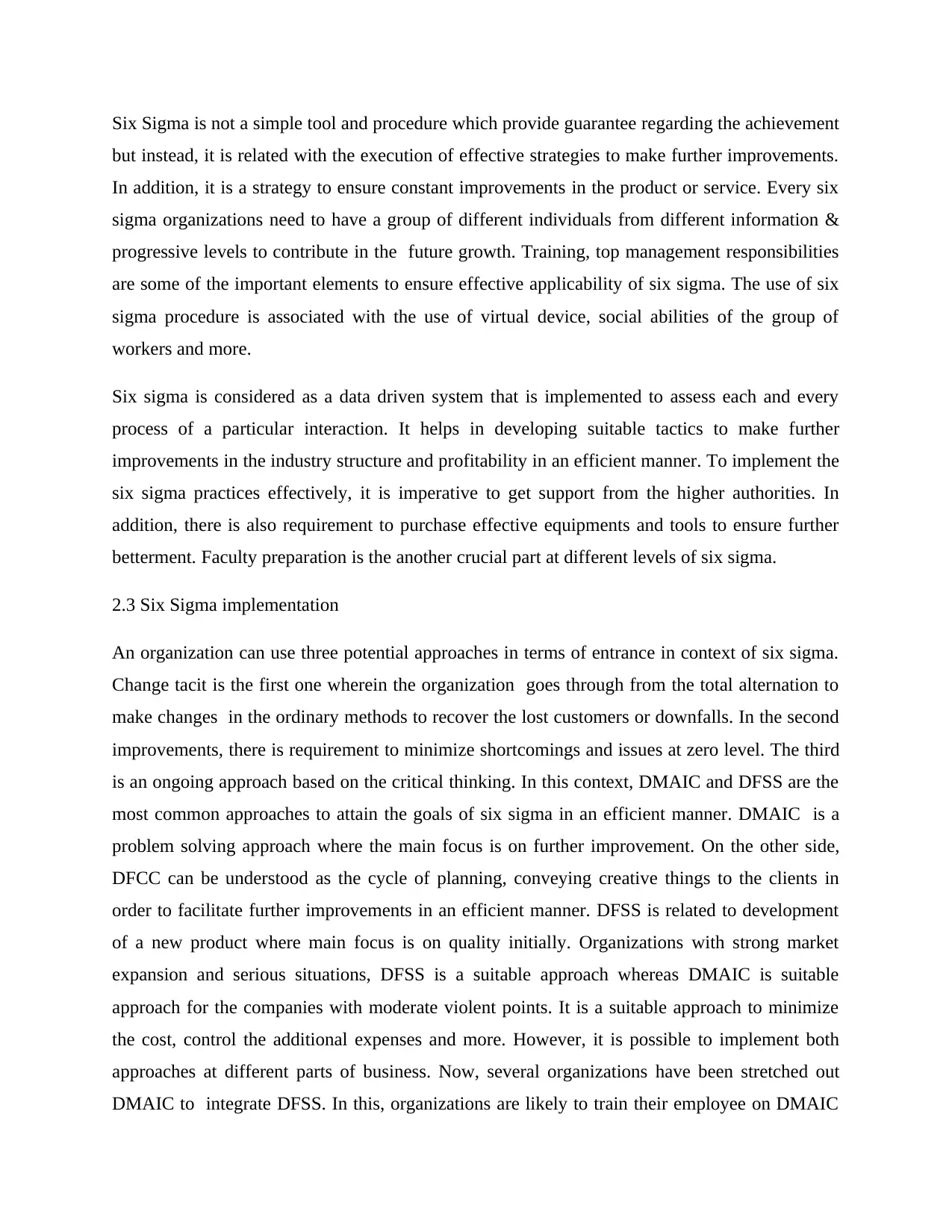
Six Sigma is not a simple tool and procedure which provide guarantee regarding the achievement
but instead, it is related with the execution of effective strategies to make further improvements.
In addition, it is a strategy to ensure constant improvements in the product or service. Every six
sigma organizations need to have a group of different individuals from different information &
progressive levels to contribute in the future growth. Training, top management responsibilities
are some of the important elements to ensure effective applicability of six sigma. The use of six
sigma procedure is associated with the use of virtual device, social abilities of the group of
workers and more.
Six sigma is considered as a data driven system that is implemented to assess each and every
process of a particular interaction. It helps in developing suitable tactics to make further
improvements in the industry structure and profitability in an efficient manner. To implement the
six sigma practices effectively, it is imperative to get support from the higher authorities. In
addition, there is also requirement to purchase effective equipments and tools to ensure further
betterment. Faculty preparation is the another crucial part at different levels of six sigma.
2.3 Six Sigma implementation
An organization can use three potential approaches in terms of entrance in context of six sigma.
Change tacit is the first one wherein the organization goes through from the total alternation to
make changes in the ordinary methods to recover the lost customers or downfalls. In the second
improvements, there is requirement to minimize shortcomings and issues at zero level. The third
is an ongoing approach based on the critical thinking. In this context, DMAIC and DFSS are the
most common approaches to attain the goals of six sigma in an efficient manner. DMAIC is a
problem solving approach where the main focus is on further improvement. On the other side,
DFCC can be understood as the cycle of planning, conveying creative things to the clients in
order to facilitate further improvements in an efficient manner. DFSS is related to development
of a new product where main focus is on quality initially. Organizations with strong market
expansion and serious situations, DFSS is a suitable approach whereas DMAIC is suitable
approach for the companies with moderate violent points. It is a suitable approach to minimize
the cost, control the additional expenses and more. However, it is possible to implement both
approaches at different parts of business. Now, several organizations have been stretched out
DMAIC to integrate DFSS. In this, organizations are likely to train their employee on DMAIC
but instead, it is related with the execution of effective strategies to make further improvements.
In addition, it is a strategy to ensure constant improvements in the product or service. Every six
sigma organizations need to have a group of different individuals from different information &
progressive levels to contribute in the future growth. Training, top management responsibilities
are some of the important elements to ensure effective applicability of six sigma. The use of six
sigma procedure is associated with the use of virtual device, social abilities of the group of
workers and more.
Six sigma is considered as a data driven system that is implemented to assess each and every
process of a particular interaction. It helps in developing suitable tactics to make further
improvements in the industry structure and profitability in an efficient manner. To implement the
six sigma practices effectively, it is imperative to get support from the higher authorities. In
addition, there is also requirement to purchase effective equipments and tools to ensure further
betterment. Faculty preparation is the another crucial part at different levels of six sigma.
2.3 Six Sigma implementation
An organization can use three potential approaches in terms of entrance in context of six sigma.
Change tacit is the first one wherein the organization goes through from the total alternation to
make changes in the ordinary methods to recover the lost customers or downfalls. In the second
improvements, there is requirement to minimize shortcomings and issues at zero level. The third
is an ongoing approach based on the critical thinking. In this context, DMAIC and DFSS are the
most common approaches to attain the goals of six sigma in an efficient manner. DMAIC is a
problem solving approach where the main focus is on further improvement. On the other side,
DFCC can be understood as the cycle of planning, conveying creative things to the clients in
order to facilitate further improvements in an efficient manner. DFSS is related to development
of a new product where main focus is on quality initially. Organizations with strong market
expansion and serious situations, DFSS is a suitable approach whereas DMAIC is suitable
approach for the companies with moderate violent points. It is a suitable approach to minimize
the cost, control the additional expenses and more. However, it is possible to implement both
approaches at different parts of business. Now, several organizations have been stretched out
DMAIC to integrate DFSS. In this, organizations are likely to train their employee on DMAIC
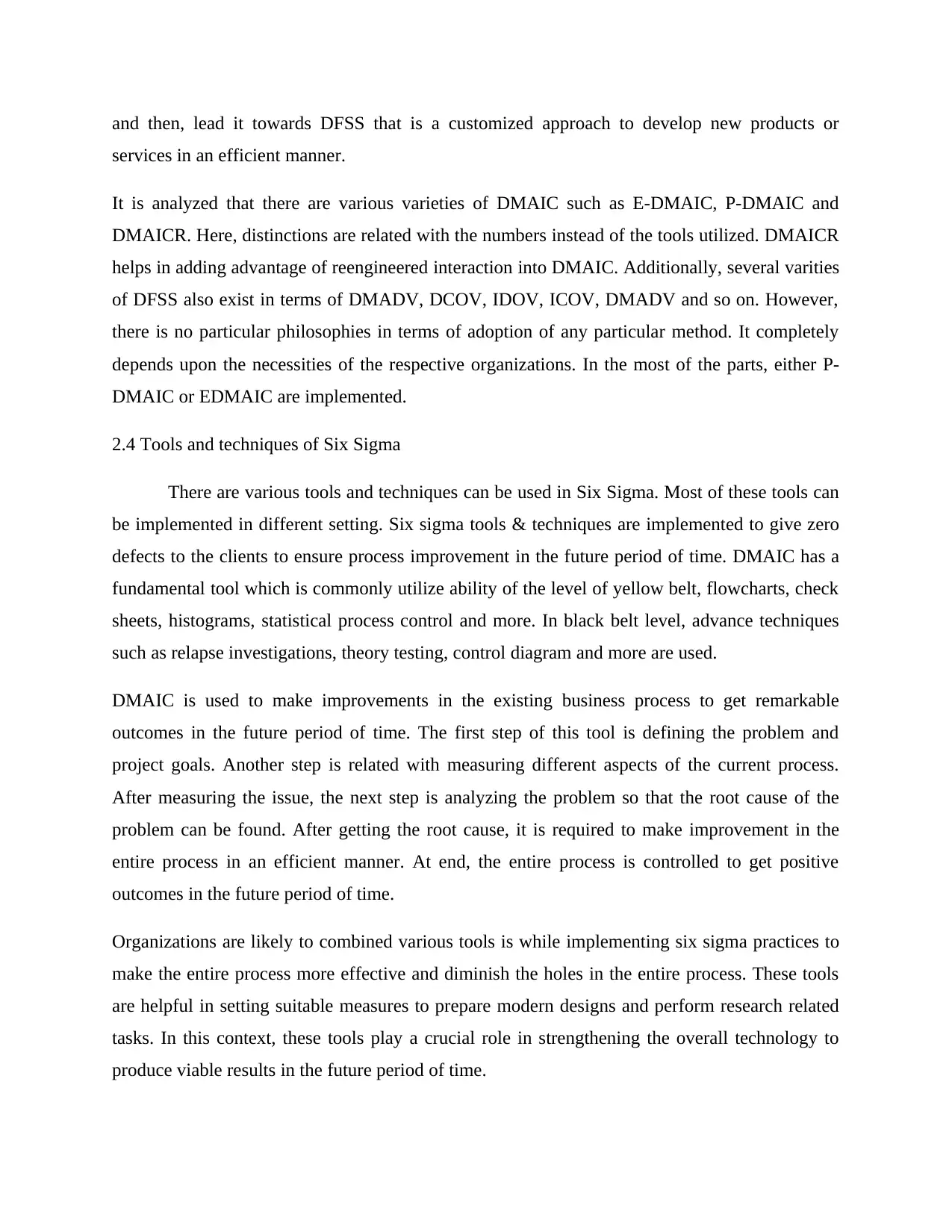
and then, lead it towards DFSS that is a customized approach to develop new products or
services in an efficient manner.
It is analyzed that there are various varieties of DMAIC such as E-DMAIC, P-DMAIC and
DMAICR. Here, distinctions are related with the numbers instead of the tools utilized. DMAICR
helps in adding advantage of reengineered interaction into DMAIC. Additionally, several varities
of DFSS also exist in terms of DMADV, DCOV, IDOV, ICOV, DMADV and so on. However,
there is no particular philosophies in terms of adoption of any particular method. It completely
depends upon the necessities of the respective organizations. In the most of the parts, either P-
DMAIC or EDMAIC are implemented.
2.4 Tools and techniques of Six Sigma
There are various tools and techniques can be used in Six Sigma. Most of these tools can
be implemented in different setting. Six sigma tools & techniques are implemented to give zero
defects to the clients to ensure process improvement in the future period of time. DMAIC has a
fundamental tool which is commonly utilize ability of the level of yellow belt, flowcharts, check
sheets, histograms, statistical process control and more. In black belt level, advance techniques
such as relapse investigations, theory testing, control diagram and more are used.
DMAIC is used to make improvements in the existing business process to get remarkable
outcomes in the future period of time. The first step of this tool is defining the problem and
project goals. Another step is related with measuring different aspects of the current process.
After measuring the issue, the next step is analyzing the problem so that the root cause of the
problem can be found. After getting the root cause, it is required to make improvement in the
entire process in an efficient manner. At end, the entire process is controlled to get positive
outcomes in the future period of time.
Organizations are likely to combined various tools is while implementing six sigma practices to
make the entire process more effective and diminish the holes in the entire process. These tools
are helpful in setting suitable measures to prepare modern designs and perform research related
tasks. In this context, these tools play a crucial role in strengthening the overall technology to
produce viable results in the future period of time.
services in an efficient manner.
It is analyzed that there are various varieties of DMAIC such as E-DMAIC, P-DMAIC and
DMAICR. Here, distinctions are related with the numbers instead of the tools utilized. DMAICR
helps in adding advantage of reengineered interaction into DMAIC. Additionally, several varities
of DFSS also exist in terms of DMADV, DCOV, IDOV, ICOV, DMADV and so on. However,
there is no particular philosophies in terms of adoption of any particular method. It completely
depends upon the necessities of the respective organizations. In the most of the parts, either P-
DMAIC or EDMAIC are implemented.
2.4 Tools and techniques of Six Sigma
There are various tools and techniques can be used in Six Sigma. Most of these tools can
be implemented in different setting. Six sigma tools & techniques are implemented to give zero
defects to the clients to ensure process improvement in the future period of time. DMAIC has a
fundamental tool which is commonly utilize ability of the level of yellow belt, flowcharts, check
sheets, histograms, statistical process control and more. In black belt level, advance techniques
such as relapse investigations, theory testing, control diagram and more are used.
DMAIC is used to make improvements in the existing business process to get remarkable
outcomes in the future period of time. The first step of this tool is defining the problem and
project goals. Another step is related with measuring different aspects of the current process.
After measuring the issue, the next step is analyzing the problem so that the root cause of the
problem can be found. After getting the root cause, it is required to make improvement in the
entire process in an efficient manner. At end, the entire process is controlled to get positive
outcomes in the future period of time.
Organizations are likely to combined various tools is while implementing six sigma practices to
make the entire process more effective and diminish the holes in the entire process. These tools
are helpful in setting suitable measures to prepare modern designs and perform research related
tasks. In this context, these tools play a crucial role in strengthening the overall technology to
produce viable results in the future period of time.
⊘ This is a preview!⊘
Do you want full access?
Subscribe today to unlock all pages.

Trusted by 1+ million students worldwide
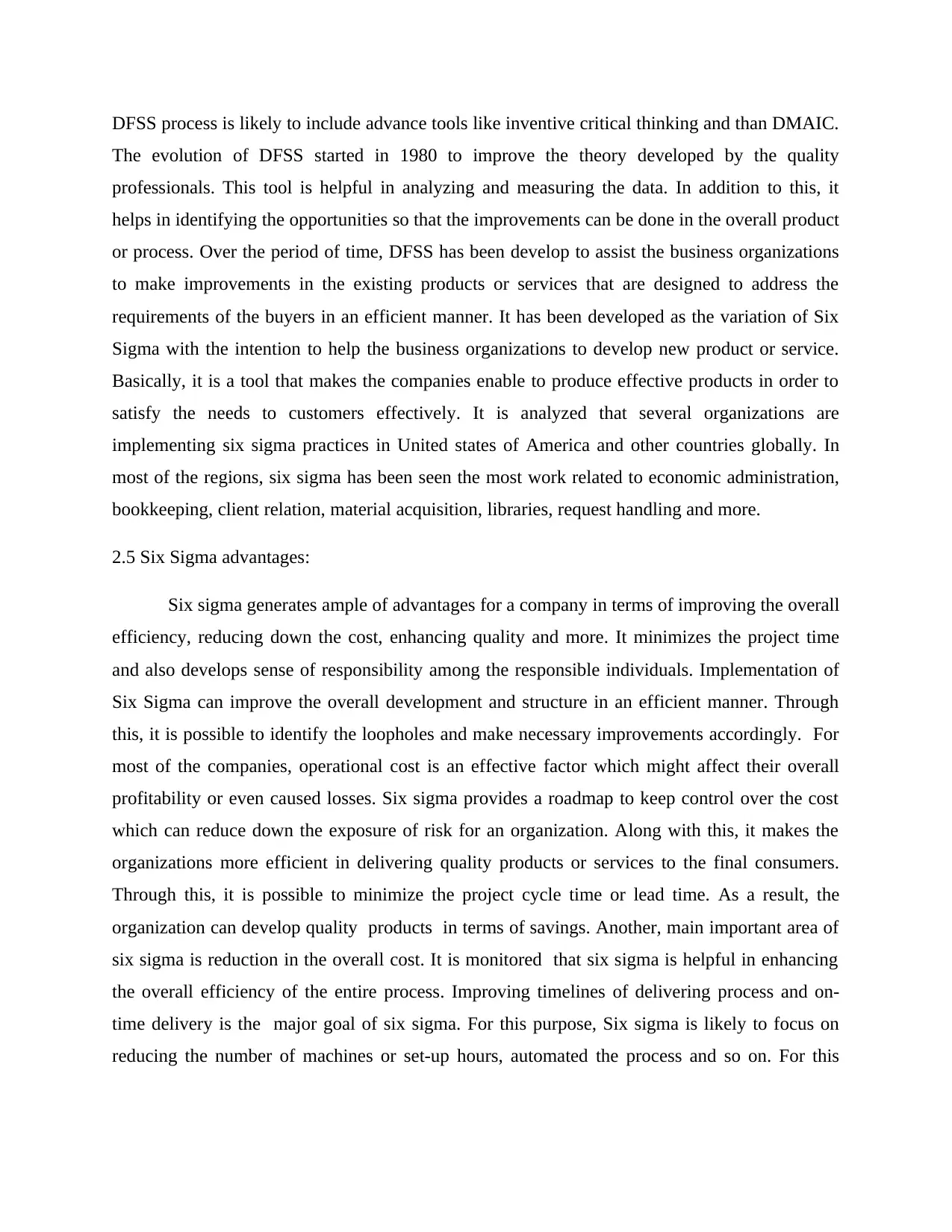
DFSS process is likely to include advance tools like inventive critical thinking and than DMAIC.
The evolution of DFSS started in 1980 to improve the theory developed by the quality
professionals. This tool is helpful in analyzing and measuring the data. In addition to this, it
helps in identifying the opportunities so that the improvements can be done in the overall product
or process. Over the period of time, DFSS has been develop to assist the business organizations
to make improvements in the existing products or services that are designed to address the
requirements of the buyers in an efficient manner. It has been developed as the variation of Six
Sigma with the intention to help the business organizations to develop new product or service.
Basically, it is a tool that makes the companies enable to produce effective products in order to
satisfy the needs to customers effectively. It is analyzed that several organizations are
implementing six sigma practices in United states of America and other countries globally. In
most of the regions, six sigma has been seen the most work related to economic administration,
bookkeeping, client relation, material acquisition, libraries, request handling and more.
2.5 Six Sigma advantages:
Six sigma generates ample of advantages for a company in terms of improving the overall
efficiency, reducing down the cost, enhancing quality and more. It minimizes the project time
and also develops sense of responsibility among the responsible individuals. Implementation of
Six Sigma can improve the overall development and structure in an efficient manner. Through
this, it is possible to identify the loopholes and make necessary improvements accordingly. For
most of the companies, operational cost is an effective factor which might affect their overall
profitability or even caused losses. Six sigma provides a roadmap to keep control over the cost
which can reduce down the exposure of risk for an organization. Along with this, it makes the
organizations more efficient in delivering quality products or services to the final consumers.
Through this, it is possible to minimize the project cycle time or lead time. As a result, the
organization can develop quality products in terms of savings. Another, main important area of
six sigma is reduction in the overall cost. It is monitored that six sigma is helpful in enhancing
the overall efficiency of the entire process. Improving timelines of delivering process and on-
time delivery is the major goal of six sigma. For this purpose, Six sigma is likely to focus on
reducing the number of machines or set-up hours, automated the process and so on. For this
The evolution of DFSS started in 1980 to improve the theory developed by the quality
professionals. This tool is helpful in analyzing and measuring the data. In addition to this, it
helps in identifying the opportunities so that the improvements can be done in the overall product
or process. Over the period of time, DFSS has been develop to assist the business organizations
to make improvements in the existing products or services that are designed to address the
requirements of the buyers in an efficient manner. It has been developed as the variation of Six
Sigma with the intention to help the business organizations to develop new product or service.
Basically, it is a tool that makes the companies enable to produce effective products in order to
satisfy the needs to customers effectively. It is analyzed that several organizations are
implementing six sigma practices in United states of America and other countries globally. In
most of the regions, six sigma has been seen the most work related to economic administration,
bookkeeping, client relation, material acquisition, libraries, request handling and more.
2.5 Six Sigma advantages:
Six sigma generates ample of advantages for a company in terms of improving the overall
efficiency, reducing down the cost, enhancing quality and more. It minimizes the project time
and also develops sense of responsibility among the responsible individuals. Implementation of
Six Sigma can improve the overall development and structure in an efficient manner. Through
this, it is possible to identify the loopholes and make necessary improvements accordingly. For
most of the companies, operational cost is an effective factor which might affect their overall
profitability or even caused losses. Six sigma provides a roadmap to keep control over the cost
which can reduce down the exposure of risk for an organization. Along with this, it makes the
organizations more efficient in delivering quality products or services to the final consumers.
Through this, it is possible to minimize the project cycle time or lead time. As a result, the
organization can develop quality products in terms of savings. Another, main important area of
six sigma is reduction in the overall cost. It is monitored that six sigma is helpful in enhancing
the overall efficiency of the entire process. Improving timelines of delivering process and on-
time delivery is the major goal of six sigma. For this purpose, Six sigma is likely to focus on
reducing the number of machines or set-up hours, automated the process and so on. For this
Paraphrase This Document
Need a fresh take? Get an instant paraphrase of this document with our AI Paraphraser
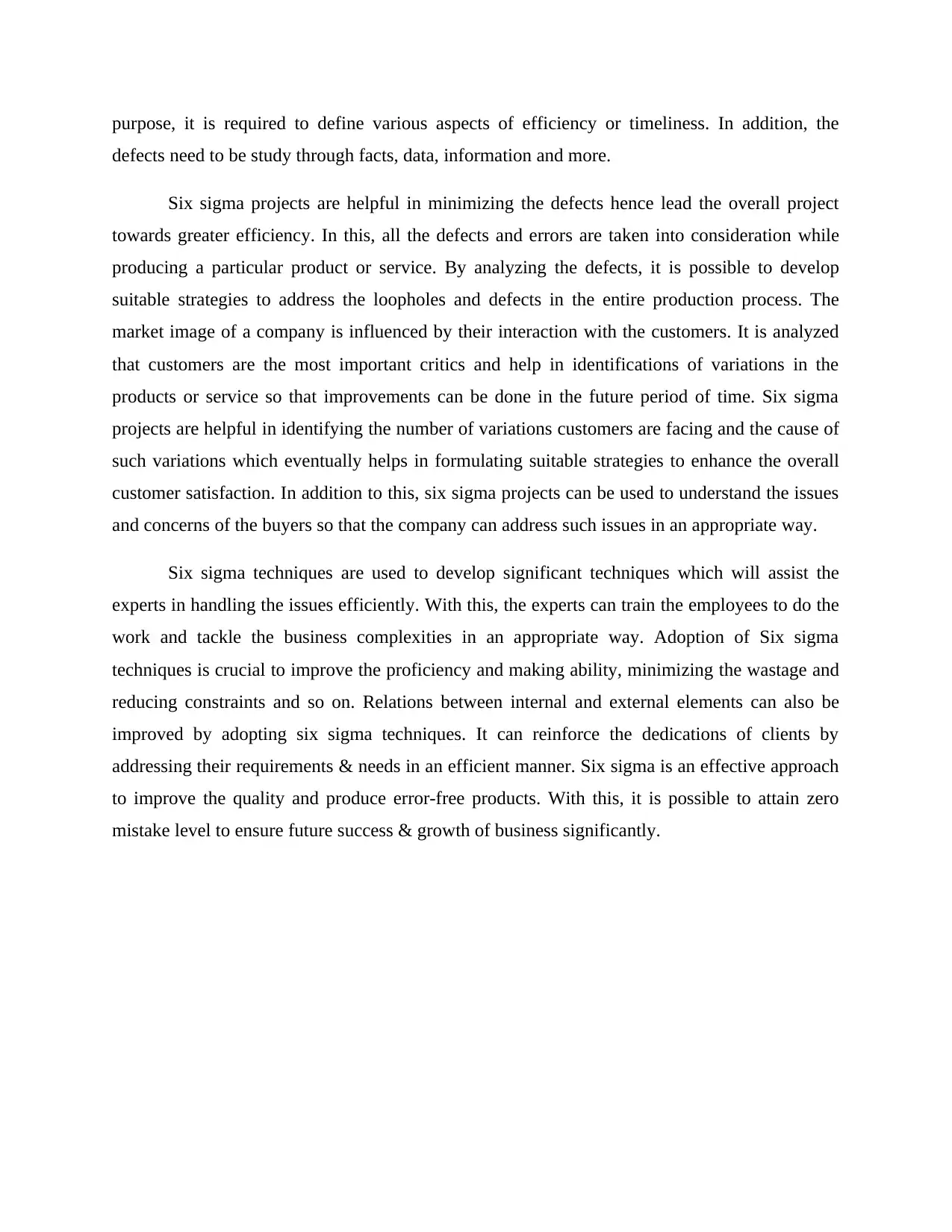
purpose, it is required to define various aspects of efficiency or timeliness. In addition, the
defects need to be study through facts, data, information and more.
Six sigma projects are helpful in minimizing the defects hence lead the overall project
towards greater efficiency. In this, all the defects and errors are taken into consideration while
producing a particular product or service. By analyzing the defects, it is possible to develop
suitable strategies to address the loopholes and defects in the entire production process. The
market image of a company is influenced by their interaction with the customers. It is analyzed
that customers are the most important critics and help in identifications of variations in the
products or service so that improvements can be done in the future period of time. Six sigma
projects are helpful in identifying the number of variations customers are facing and the cause of
such variations which eventually helps in formulating suitable strategies to enhance the overall
customer satisfaction. In addition to this, six sigma projects can be used to understand the issues
and concerns of the buyers so that the company can address such issues in an appropriate way.
Six sigma techniques are used to develop significant techniques which will assist the
experts in handling the issues efficiently. With this, the experts can train the employees to do the
work and tackle the business complexities in an appropriate way. Adoption of Six sigma
techniques is crucial to improve the proficiency and making ability, minimizing the wastage and
reducing constraints and so on. Relations between internal and external elements can also be
improved by adopting six sigma techniques. It can reinforce the dedications of clients by
addressing their requirements & needs in an efficient manner. Six sigma is an effective approach
to improve the quality and produce error-free products. With this, it is possible to attain zero
mistake level to ensure future success & growth of business significantly.
defects need to be study through facts, data, information and more.
Six sigma projects are helpful in minimizing the defects hence lead the overall project
towards greater efficiency. In this, all the defects and errors are taken into consideration while
producing a particular product or service. By analyzing the defects, it is possible to develop
suitable strategies to address the loopholes and defects in the entire production process. The
market image of a company is influenced by their interaction with the customers. It is analyzed
that customers are the most important critics and help in identifications of variations in the
products or service so that improvements can be done in the future period of time. Six sigma
projects are helpful in identifying the number of variations customers are facing and the cause of
such variations which eventually helps in formulating suitable strategies to enhance the overall
customer satisfaction. In addition to this, six sigma projects can be used to understand the issues
and concerns of the buyers so that the company can address such issues in an appropriate way.
Six sigma techniques are used to develop significant techniques which will assist the
experts in handling the issues efficiently. With this, the experts can train the employees to do the
work and tackle the business complexities in an appropriate way. Adoption of Six sigma
techniques is crucial to improve the proficiency and making ability, minimizing the wastage and
reducing constraints and so on. Relations between internal and external elements can also be
improved by adopting six sigma techniques. It can reinforce the dedications of clients by
addressing their requirements & needs in an efficient manner. Six sigma is an effective approach
to improve the quality and produce error-free products. With this, it is possible to attain zero
mistake level to ensure future success & growth of business significantly.
1 out of 8
Related Documents
Your All-in-One AI-Powered Toolkit for Academic Success.
+13062052269
info@desklib.com
Available 24*7 on WhatsApp / Email
![[object Object]](/_next/static/media/star-bottom.7253800d.svg)
Unlock your academic potential
Copyright © 2020–2025 A2Z Services. All Rights Reserved. Developed and managed by ZUCOL.





